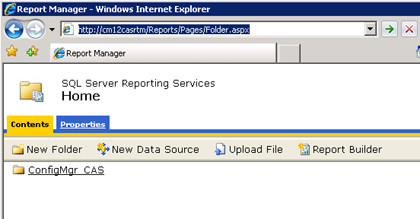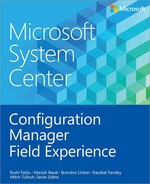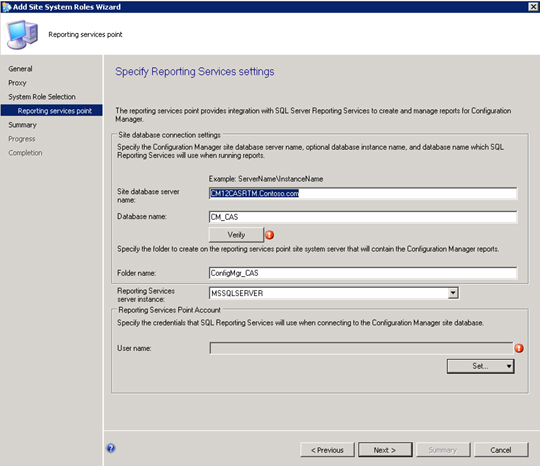CHAPTER 3
Integrating SQL Server Reporting Services with Configuration Manager 2012
In Microsoft System Center 2012 Configuration Manager the legacy reporting point has been replaced with the Reporting services point, which uses SQL Server Reporting Services (SSRS). A common question is: How can you use and customize reports using SSRS? If you aren’t familiar with SQL queries, you might be hesitant to use SSRS. This chapter shows you how easy it is to create custom reports. However, before you start using SSRS, the first step is to integrate SSRS with Configuration Manager.
This chapter covers the process of installing an SSRS services point using the Configuration Manager console. The next chapter describes the process of customizing and running reports using SSRS.
Prerequisites for reporting services points in Configuration Manager 2012
There are some prerequisites before you are able to integrate SSRS with Configuration Manager 2012. Before you can install a reporting services point in Configuration Manager, you must ensure that SSRS is installed and configured properly. The following example uses Microsoft SQL Server 2008.
1. Click Start, select All Programs, Microsoft SQL Server 2008, Configuration Tools, and then select Reporting Services Configuration Manager.
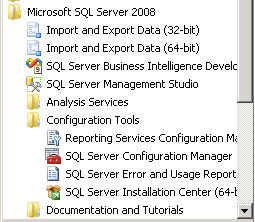
2. In the Reporting Services Configuration Connection dialog box, click Connect.
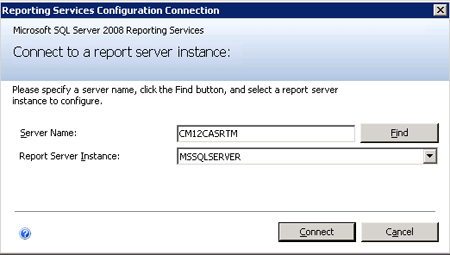
3. On the Report Server Status page, make sure Report Service Status is set to Started. If not, click Start to start the service.
4. On the Web Service URL page, click Apply to configure the Report Server Web Service. This creates a virtual directory called ReportServer.
5. Click the Database tab and make sure Report Server Mode is set to Native. If you are setting this for the first time, you are prompted to create a new report server database or use an existing one. Choose the Create A New Report Server Database option and then click Next.
6. Click Test Connection to make sure it works.
7. Specify the Database Name (the default is ReportServer), set the Report Server Mode to Native, and click Next.
8. Click Next on the Credentials page to accept the default settings.
9. Click Next on the Summary page to complete the wizard.
10. On the Report Manager URL page, click Apply to setup the Report Manager virtual directory. This creates a virtual directory called Reports.
11. On the Report Manager URL page, click the URLs link for http://<Servername>:80/Reports to make sure you are able to connect. It might ask you for a username and password.
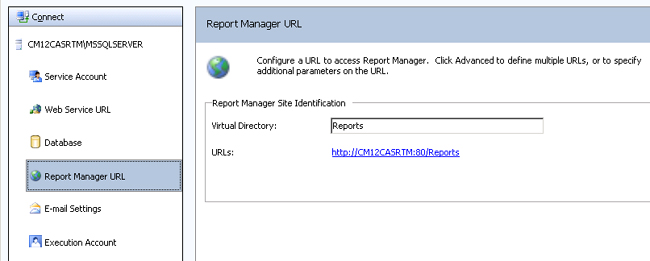
Installing a Reporting services point
After you confirm the installation and configuration of SSRS, the next step is to integrate SSRS with Configuration Manager 2012 by installing a Reporting services point using the Configuration Manager console. This process copies the report folders and reports to SSRS and applies the appropriate security for the folders and reports. After you install the reporting services point, do not change the SSRS Report Server URL because Configuration Manager will continue to use the original URL and you will be unable to run the reports. To change the URL, you must uninstall the reporting services point, change the URL, and then reinstall the reporting services point.
To install a reporting services point, follow these steps:
1. Connect to the Configuration Manager console.
2. Select Administration, Site Configuration, Server And Site System Roles.
3. Right-click the server on which you want to install the reporting services point and click Add Site System Roles to start the wizard.
4. On the General page, accept the default settings and click Next.
5. On the Proxy page, accept the default settings and click Next.
6. On the System Role Selection page, select Reporting Services Point and click Next.
7. On the Reporting Services Point page, specify the Configuration Manager site database server name and the database name.
IMPORTANT If your SQL server is remote, specify the SQL server name and not the Configuration Manager database server name. If you accidently specify the Configuration Manager database server name when your SQL server is remote, you might see the following error message: “Unable to locate any configured SRS instances on the server. Verify SRS is installed, accessible, and correctly configured.”
8. Click Verify to make sure the wizard has access to the site database.
9. Specify the folder name that will host the Configuration Manager reports.
10. Click Set to specify a reporting services point account and click Next. The reporting services point account must have Read rights to the site database.
11. On the Summary page, click Next to complete the Reporting Services Point Installation Wizard.
12. On the Completion page, click Close.
13. Review srsrpMSI.log and srsrpsetup.log for any errors. These logs are located in the %ProgramFiles%Microsoft Configuration ManagerLogs directory.

14. When the reporting services point is installed successfully, connect to http://<Servername>/Reports to make sure the Configuration Manager database is listed and you are able to access it.
